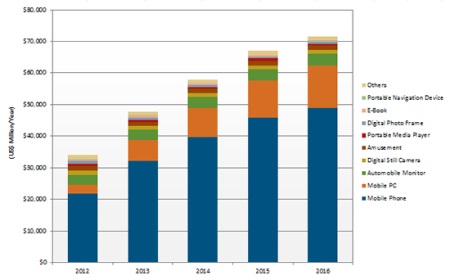
Smart lighting
The research company NanoMarkets says that revenues from smart lighting are expected to escalate rapidly in the coming decade, driven primarily by rising energy costs. However, the biggest wins in the smart lighting business will go to those who can differentiate themselves in the market by offering value-added features and interfaces to other building automation systems. The latest lighting research indicates that smart lighting can also lead to improved health and mood, while newer technology is showing the way to using smart-lighting systems for air quality monitoring and even the delivery of information services. At the same time, improved control algorithms will permit the basic lighting management functionality of smart lighting to be performed much more effectively.
The report shows how new value is being created in the lighting market by adding enhanced electronics and intelligent luminaires and how such product strategies will be able to build on the massive trend towards introducing LED lighting. It examines what the prospects for start-ups are in this space. There is an eight-year market forecast with breakouts by type of product, end user market segment, and the regions/countries where this report will be sold. The research company says this report will provide much needed data and strategic analysis for planners and marketers throughout the lighting, semiconductor, sensor, and networking industries. For more information see http://tinyurl.com/ln9ld9g
Small, medium flat-panel outlook
Demand for larger screens, higher resolution, and advanced touch functionality on smartphones and mobile PCs, in particular tablet PCs, will boost small/medium flat panel display market revenue to $71.5 billion by 2016, up 100%Y/Y, according to the NPD DisplaySearch Quarterly Small/Medium Shipment and Forecast Report.

Revenue forecast for small-to-medium AMFPD technology (2012-2016)
Competition among top smartphone brands has driven flat panel display (FPD) makers to produce more high-grade technologies, such as AMOLED displays for Samsung’s Galaxy S and retina displays for Apple’s iPhone. See http://tinyurl.com/n7r2svq for more information.
Samsung bets on AMOLED
Active matrix organic LED (AMOLED) displays are most likely to have the greatest amount of influence on innovation in smart devices, according to Kinam Kim, CEO of Samsung Display. He thinks that the future of displays will change considerably, with special attention given to the large number of imaging possibilities in AMOLED display technology.
The spread of cloud computing, the accelerating evolution of high-speed networks, and the spread of connectivity among electronic devices will likely make displays the central focus of the pervasive electronic device. In the cloud environment, the capability of electronic networked devices for data processing and storage will allow users to enjoy content that only highly advanced devices can fully process today, including ultra HD (3,840 x 2,160) images and 3D games. The speed of 4G LTE will rise to 3 Gbits/s by 2015 so UHD-resolution movies can be downloaded in www.samsungdisplay.com
Advertisement
Learn more about Electronic Products Magazine





